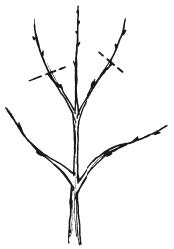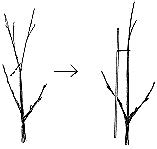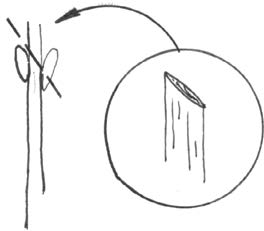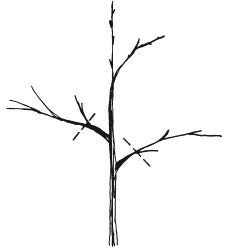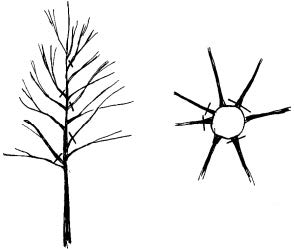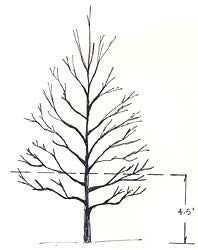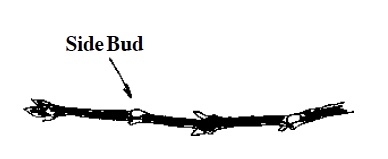Introduction
Every nurseryman should know how to prune trees and the reason for the various pruning practices. Many landscape problems can be avoided if correct pruning is performed, while the tree is growing in the nursery. Incorrect pruning practices or lack of pruning diminish the quality of the plant material.
Early Stages
The most important aspect of early growth during the first year after planting is in root initiation and establishment. Unless large whips have been planted, pruning is generally not a critical practice at this time, as many of the smaller lower branches can aid in stem taper or trunk caliper and thus should be left on the tree. General pruning should be confined to large lateral branches which are out-of-scale and with maintenance of a main leader. Large lateral branches may be pruned back to 2 to 3 buds to help caliper development of the lower stem.
Terminals of leaders may dieback during the first season. For misshaped seedling trees, often the best choice is to cut them off approximately 1 inch above the ground just before bud break the second season. This takes considerable courage, however shoots soon develop at the base of the stem. For single leader trees, the one most vigorous and straightest is selected and the others removed. For clumped or multi-stemmed trees such as river birch, and crape myrtle 3 to 5 stems should be left.
The species growth habit generally dictates pruning requirements during the second and third growing seasons. It is easiest to work with the natural growth habit of a species than to change the natural form. Trees such as oaks, ‘Bradford Pear’ or maples are usually pruned to maintain a single leader and well spaced, wide angled branches. Other trees such as crabapple cultivars may be pruned to form 3 to 5 modified leaders with wide scaffold branches.
Summer Pruning
Summer pruning in deciduous trees would include (1) the removal of watersprouts (small shoots) along the trunk and base and (2) the maintenance of a single straight leader. Theoretically, most pruning of deciduous trees is best performed during the dormant season, but corrective shaping is essential and should be done at the first possible chance. Broken, damaged and dead branches are best removed when observed.
Broadleaved upright plants such as ‘Nellie R. Stevens’ and ‘Fosters #2’ hollies need attention throughout the summer months. The terminals should be tip pruned to increase branching density.
A strong vertical terminal should grow 8 to 10 inches long before being pruned. Later on in the season as the growth develops, another central terminal should be selected.
Fire blight susceptible trees such as crabapple, pear, and other rosaceous species may require extra spring and summer pruning. Tips of branches are blackened as the disease moves down the branch. To control the disease, prune at buds or branches well below the discolored area. (This may be 12 to 15 inches on infected branches.) Pruning equipment should be disinfected by wetting all cutting surfaces with isopropyl alcohol, 10% chlorox solution, or saturated copper sulfate solution. This disease is easily spread by non-disinfected pruning shears.
Winter Pruning
Extensive pruning of deciduous nursery stock is best completed before plants break dormancy. The branch structure is more easily seen and pruning at this time will stimulate growth on remaining branches. Pruning should be limited to removal of no more than a third (1/3) of the total bud and leaf bearing branches. Otherwise extensive water sprouting may result.
Depending upon the intended use, customer demand and market, deciduous shade trees are usually limbed up from 36 to 60 inches. Smaller flowering trees usually branch lower than larger trees and may be as low as 24 inches. Boulevard and parking island trees need higher clearance than specimen and residential trees.
To maintain a dominant leader, prune competing lateral branches or the tree will develop multiple leaders. If one leader is straight, prune angled branches. Approximately one-half their length may be removed by cutting to an outward facing bud (Figure 1).
If neither leader is straight, remove one and consider staking. It is also possible to tie them together and cut one back, then cut off the short one at the end of the growing season (Figure 2).
When cutting back a leader on opposite budded trees, a double leader will develop unless one bud is eliminated. To remove one bud, make a slanted cut above the bud to be left, trying not to expose the stem directly behind it but removing the opposite bud or roll out (pinch out) one bud (Figure 3).
Extra large or long lower branches also suppress terminal growth and should be removed or cut back to at least one-half their length. Some growers cut small branches less than one-fourth inch back to 1 or 2 buds and allow shoots to grow until the end of the season. This helps increase lower stem caliper during that season and then they are removed during the next dormant pruning cycle (Figure 4).
Prune out crossing, inward growing, parallel and competing branches. Branches growing in the center of multi-leadered trees such as river birch (Figure 5a) and crepemyrtle (Figure 5b) should be removed so that attention is focused on exfoliating bark.
Scaffold branches are permanent branches which make up the frame of the tree. When trees are small, tiers of branches may be 3 to 6 inches apart such as in Pyrus cultivars. During the next two years in the field, pruning to develop spacing between whorls to a foot or more is desireable. Branches should also be well spaced around the trunk. Acutely angled limbs are weaker than more horizontially growing branches and should be eliminated. Parallel branches growing in the same plane, one above the other should also be eliminated by removing one of them. Branches growing back toward the trunk or across other branches should be removed. By making these choices, well spaced branching may be accomplished (Figure 6).
The height of the first branches is usually determined by the market sought and size of tree being sold. The bottom branches for small flowering trees like dogwood or kwanzan cherry may be left low at 11/ to 3 ft. Small residential shade trees may begin at 3 ft in height. Large caliper trees for boulevard or street use may be pruned to 4 ft or higher to reduce maintenance conflicts (Figure 7).
Buds left on the end of pruned branches form the next tier branches. Pruning influences their direction. On opposite budded trees it is good practice to prune back to buds facing to the side rather than up and down. This can be used to stimulate branching on light branched trees. If branches are cut back to side buds it can double the number of branches when the tree starts to grow (Figure 8).
Current research indicates that flush cuts are no longer recommended. Cut just beyond the branch collar perpendicular to the branch being pruned rather than as close to the trunk as possible. This minimizes the size of the wound (Figure 9).
An identifiable quality of nursery grown shade trees is a straight leader and good branch structure. Along with other management skills and good pruning practices, a grower should be able to improve the quality of field grown trees and increase the percent of marketable plants in his fields.
Publication date: Jan. 1, 1993
N.C. Cooperative Extension prohibits discrimination and harassment regardless of age, color, disability, family and marital status, gender identity, national origin, political beliefs, race, religion, sex (including pregnancy), sexual orientation and veteran status.

